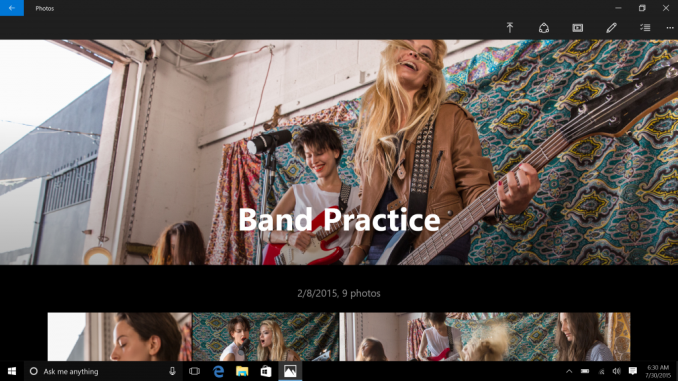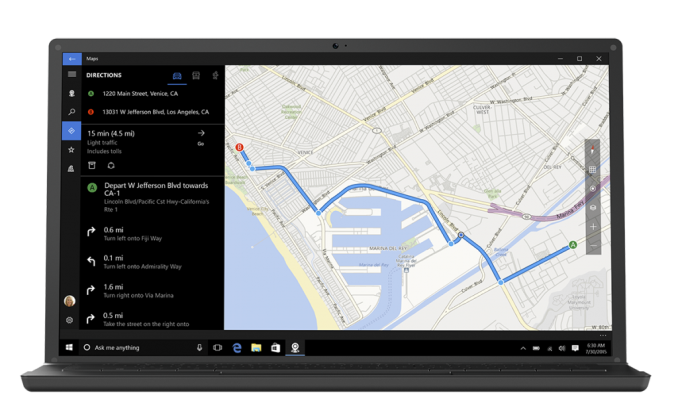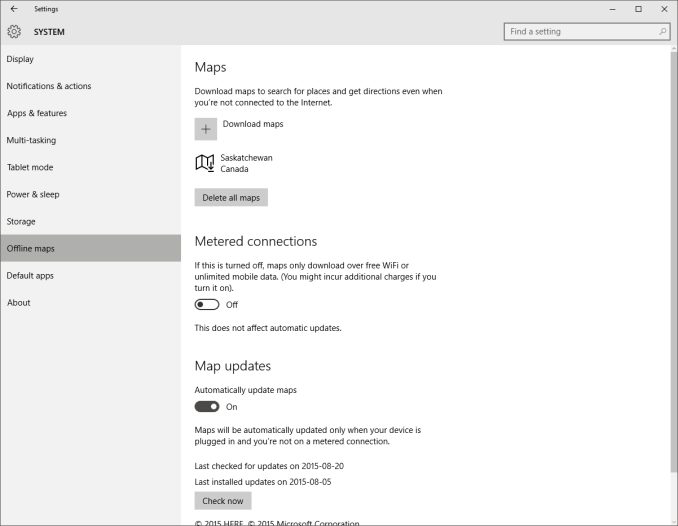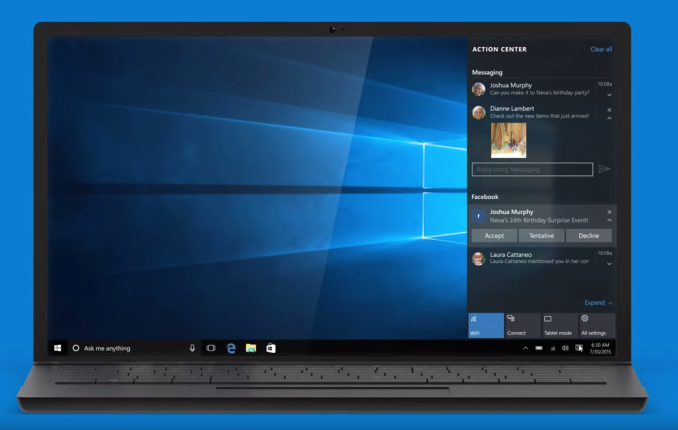The Windows 10 Review: The Old & New Face of Windows
by Brett Howse on August 25, 2015 8:00 AM EST- Posted in
- Operating Systems
- Microsoft
- Windows 10
Photos
Another app that was in desperate need of attention was Photos. The Windows 8 photos app was frankly a nightmare, and it was one of the first things I disabled on any new install. The new version is far superior to what came before, in both looks and functionality.
Once again, we have a Universal Windows App which means that it can scale and reflow to fit any display size or window. By default, it grabs pictures from your pictures folders in your user profile as well as OneDrive, and you can also toggle whether or not to show pictures from OneDrive which are not synced with your PC.
Once in the app, you can browse photos by your collection, which shows all photos, or by albums. Collection is pretty self explanatory, and just contains a list of all photos in chronological order. There is no way to sort any other way, although you can click on a month to jump to another date. The albums view is a lot different though, and the system will automatically create albums based on time and location in your photos, and then present them to you. You can change what photos are in the album if you want to.
The Photos app does some nice things like automatically not displaying duplicate photos, and it can clean up images and remove red-eye in a non-destructive manner. If you don’t like the auto-enhance, it can be turned off.
The Photos app is now the default app for viewing pictures, and it supports most photo and video file types, and they recently added GIF support which is one format that was left out of the previous photos app in Windows 8.
It is a good improvement over the Windows 8 version, and being a Universal Windows App means it supports high DPI and multiple display sizes. I’d like to be able to create my own albums, and that is not possible yet. The change is going to be pretty drastic for those coming from Windows 7 though, and people tend to not like change.
Maps
I’d be curious to see how many people use mapping in an app on the desktop compared to mobile systems. I tend to gravitate to the web on my desktop when I need mapping capabilities. But with Windows 10 going to be deployed on everything from phones to Xbox, having mapping as an app is obviously important.
Microsoft leverages HERE for their mapping technology, and while Nokia recently sold the HERE divisionto a group of automotive companies, the licensing arrangement is likely part of that transfer. Mapping is a very personal experience though, and some people may love HERE maps while others can’t use them because they are missing local information. It’s an incredibly difficult industry to get into and keep up to date. Google is the obvious competitor here, and they have spent a lot of money and time to build up their mapping to the point it is now. HERE has some street view, but none in my area. One thing HERE has been working on though is interior views of places like malls. I’ve used this before on the phone and it is pretty handy although it appears to be missing from the data available right now on Windows 10.
The mapping app itself is fairly well sorted out, and it can easily do directions or searches as you would expect. The views themselves can be either from straight overhead, or you can get a bird’s eye view as well and tilt and pan the camera. On a standard 2D map this can give you a nice sense of direction, but in some locations, the maps have 3D views as well which is a very nice effect. 3D views are only available in select areas, but they are a great way to find your way around when you can use them.
Another great feature of Maps which is built right into Windows 10 is the ability to download and manage offline maps. You can pick your area and have the maps ready to go without having to wait for the lag of your internet connection. It appears to only work with the road maps though and not aerial views which makes sense when you think about how much data you would need to download for aerial views of anywhere larger than a city.
The performance of maps on the devices I have tested it on is very good. Clearly this is all being offloaded to the GPU because the rendering is fast, and rotations and panning is very smooth. Once you get into the 3D maps though it can tax the system quite a bit. I still found performance good even on integrated graphics, but on laptops it is going to create some heat to get rid of since the GPU can draw a lot of power, even on integrated devices.
Maps are good on the desktop, but you can see that this app is one that will be more important on smaller devices running Windows 10, since you’ll be able to have your offline maps available for use on the go.
Messaging
When Windows 10 was shown off in January, one of the apps that was shown was a new messaging app. Windows 8 included both a touch based Skype app, and the traditional full desktop app, but the touch version never seemed to offer as consistent of an experience as the desktop version. For Windows 10, it would be replaced with new standalone apps for messaging, phone, and video.
Windows 10 is now here, but delays in the messaging apps mean that for the moment, people who want to use Microsoft’s messaging service need to use the full desktop version of Skype, since the touch version has been removed from the store for all users except those on Windows RT.
Once the new messaging apps are released, I will check them out and see how well they work. Being based on Skype, the backend is at least well known and Skype itself has improved a lot as a messaging app over the last couple of years.














293 Comments
View All Comments
prophet001 - Tuesday, August 25, 2015 - link
The spyware aspect of this OS bothers me. I'll be using Windows 7 until this is reconsidered.Michael Bay - Tuesday, August 25, 2015 - link
So, the same spyware.prophet001 - Tuesday, August 25, 2015 - link
Windows 7 doesn't even begin to approach this level of intrusion.Michael Bay - Tuesday, August 25, 2015 - link
As long as you believe that.wishgranter - Tuesday, August 25, 2015 - link
The Windows 10 EULA and Microsoft's Privacy Statement declare that Microsoft will access and use the content of people's emails and other files, such as documents uploaded to One Drive, according to Microsoft's discretion. "Share with our partners" also includes law enforcement, wherever Microsoft deems required. And I think Microsoft cannot ignore any instance which they feel should be forwarded to law enforcement without making themselves complicit in any potential criminal activity.Windows 10's all-your-contents-are-belongs-to-us policy is also a widening of the backdoor which law enforcement asks OS manufacturer to build into their systems.
Basically, Microsoft's Windows 10 EULA claims that all files used in Windows 10 may be accessed, searched, and contents utilized by Microsoft, with Microsoft exercizing sole discretion over what it will access, and how it will be used.
I think all businesses, content creators, and even nations should be dismayed at this. It looks like Russia already is concerned with Windows 10's always-on espionage against its users:
http://www.rt.com/politics/312172-windo ... ent-stirs/
If people will recall, Microsoft was previously found to be snooping in people's Outlook emails, and this discovery caused a furor among people, leading to Microsoft saying they would not do this anymore:
http://www.wired.com/2014/03/microsoft_vigilante/1
http://www.theverge.com/2014/3/20/55314 ... l-policies2
But now, Microsoft has made it a guaranteed policy of Windows 10 that they will always do this:
https://www.microsoft.com/en-gb/privacy ... fault.aspx
"Content. We collect content of your files and communications when necessary to provide you with the services you use. This includes: the content of your documents, photos, music or video you upload to a Microsoft service such as OneDrive. It also includes the content of your communications sent or received using Microsoft services, such as the:
- subject line and body of an email,
- text or other content of an instant message,
- audio and video recording of a video message, and
- audio recording and transcript of a voice message you receive or a text message you dictate."
Shouldn't there be a much bigger furor over the discretionless snooping of Windows 10, which includes all Outlook emails, than there was over just Outlook on its own?
Are people OK with their PCs contents no longer being their sole domain and in their privacy, but instead being fully open to Microsoft?
I'm not. I'll be sticking with Windows 7 for now.
Windows 10's motto: Your System is not Your Own
xenol - Tuesday, August 25, 2015 - link
You're reading the TP EULA. The actual Windows 10 EULA is at http://www.microsoft.com/en-us/Useterms/Retail/Win... , which defers the privacy stuff to Microsoft's privacy statement ( https://www.microsoft.com/en-us/privacystatement/ )Which says none or few of the things in the TP EULA (the only one I found in common is they may look at anything you upload to OneDrive, which you can disable on Windows 10 anyway)
Grooveriding - Tuesday, August 25, 2015 - link
Really unfortunate how far Microsoft went with privacy invasion and data trolling with Win 10. Fortunately you can disable what appears to be all of it with options, registry tweaks and disabling services.I would also recommend running a draconian firewall such as Tinywall that blocks all internet traffic and you have to allow applications on a case by case basis. As well as editing your hosts file to block all traffic back to Microsoft's data collection servers. As well, never use the OS with an MS account, just use a local account.
Pretty outrageous MS does not offer an option to disable everything without having to resort to these measures.
hansmuff - Tuesday, August 25, 2015 - link
The "sharing with law enforcement" is automatic for any data Microsoft has. If you're on 7 and use OneDrive, well there you go.Regarding the recording of voice data, that's a given with all of them. Siri, Google, now MS all use online services to improve detection and of course otherwise use that data. And they all send your recorded voice in some form or shape to their servers.
I can see how you'd tie it to Windows 10 because that centralizes a lot of those "new generation" of services that are in the cloud. But those services exist with or without Windows 10. I think it's wiser to educate people about what "the cloud" implies, which is exactly what you say; people do not have control over the data they store.
It's a cloud issue, and the cloud has provided the perfect vehicle for the likes of Apple, Google and Microsoft to take what they want. This goes for your PC, phone, tablet, everything.
Notmyusualid - Tuesday, August 25, 2015 - link
None of my phones or PCs send anything to the cloud.It is called privacy common sense.
Matts8 - Tuesday, August 25, 2015 - link
What phone do you have?